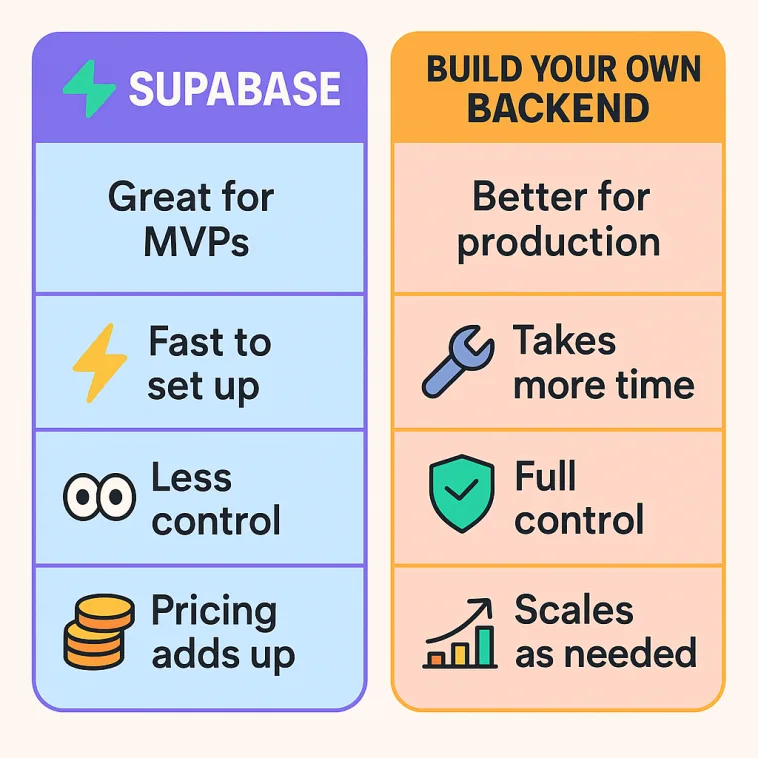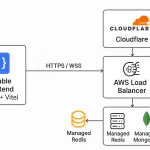Supabase is like that tool you grab during a hackathon.
It works, it is fast, it makes your app look like it belongs in a product hunt showcase.
But if you are thinking about using it for a real app, something where users trust you with actual data or money, you need a reality check.
TD Ameritrade is not running on Supabase.
Robinhood is not sending trades through Supabase servers.
Neither should you.
Today we are pulling it apart properly.
✅ What Supabase gives you
✅ What it costs once you are past the free lunch
✅ When it is a good move
✅ When it turns into a liability you cannot afford
What Supabase Actually Is
Supabase calls itself the open-source Firebase alternative.
It is basically:
- A hosted PostgreSQL database
- Auto-generated REST APIs
- A layer of GraphQL if you want it
- Authentication system
- File storage buckets
- Edge functions for custom backend code
- A nice-looking dashboard
It feels clean at first.
You skip all the annoying AWS setup and have a backend ready in an afternoon.
But the dirty secret is that it is a “one-size-fits-most” backend.
And real apps never fit neatly inside a template.
If you need custom triggers, tricky auth logic, database sharding, real-time socket scaling, anything beyond CRUD and login, Supabase will start fighting you.
You can hack around it. You can work within their limits.
Until one day you can’t.
What Supabase Costs (And How It Sneaks Up)
Here is how it looks today:
- Free Tier: $0, good for side projects
- Pro Tier: $25 per project, billed monthly
- Team Tier: $599 a month
That Pro plan sounds cheap until you realize how fast you outgrow it.
Storage limits, database size, compute power, bandwidth… everything starts getting taxed once you get real users.
And you better watch the egress costs.
Moving data out of Supabase is not free and it stacks fast.
Upload a few videos, serve them to your users, and suddenly your $25 app costs $100 this month.
At bigger scale, it gets uglier.
API usage, WebSocket churn, authentication scaling — every piece you thought was handled for you starts quietly billing by the byte or the event.
When Supabase Actually Makes Sense
Supabase is great when you are moving fast and breaking things does not matter yet.
Use it for:
- MVPs: Need something live for your startup pitch? This is your tool.
- Prototypes: Internal demos, hackathon apps, early customer feedback rounds.
- Internal Tools: CRUD apps, admin dashboards, project management toys.
Speed matters more than flexibility when your goal is to get something working, not to guarantee uptime.
If you are still trying to prove you even have a product people want, Supabase makes a ton of sense.
When You Need to Roll Your Own Backend
The second your app matters to real people, you need to rethink your stack.
That means:
- Managed PostgreSQL (AWS RDS, Google Cloud SQL)
- Custom APIs written and owned by you
- Self-managed authentication flows that you can modify as needed
- Storage control with S3 or another serious bucket system
- Serverless compute where you control the cold starts, timeouts, costs
You do this because you need to:
- Patch security issues on your schedule, not theirs
- Optimize performance for your app, not whatever fits into a general template
- Control costs by optimizing only what your app actually uses
- Meet compliance needs when you move into industries like finance, healthcare, or anything with real rules
If you think Robinhood is trusting user authentication to a third-party magic link system, you are dreaming.
They run it themselves.
Because when you own your backend, you own the rules.
You Chose…Poorly
Supabase is the right choice if you are sprinting to ship a demo, not if you are building the next Stripe or Coinbase.
If you are working on an MVP, it will save you time.
If you are building something you plan to monetize, grow, and depend on, own your backend.
The price of rebuilding later is a lot higher than the price of doing it right the first time.
Use the right tool for the stage you are at.
Launch fast when you need to.
Build properly when it counts.
Because no user cares how fast you built your app.
They only care if it works when they need it to.



